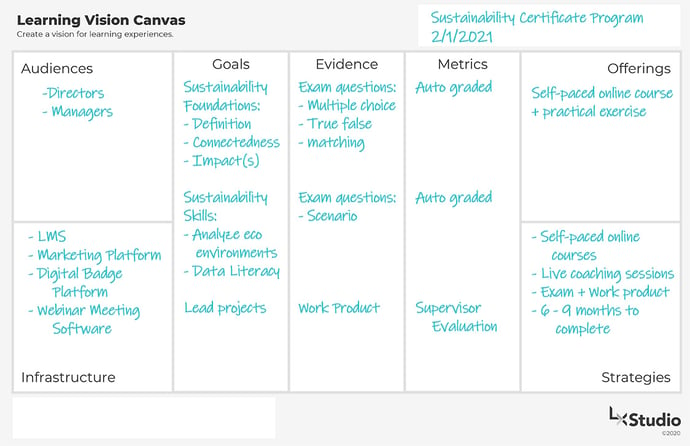
5 Steps to Creating an E-Learning Strategy
While elearning offers promising opportunities, many leaders are challenged with how to initiate a strategy that gets results and is sustainable. The complexity involved with creating a successful strategy can be overwhelming and there are relatively few practical resources to help.
The Learning Vision Canvas can be used for planning elearning. This tool breaks down learning strategies into manageable decision points that all support a broader vision and was designed to help leaders consider the essential elements needed to implement a successful strategy for their organization.

The Learning Vision Canvas organizes the core components of a learning vision around a goal and evidence. The content, audience, strategy, infrastructure, and data are all connected to the goal and evidence and are used to support a vision for learning. For example, a goal is meaningless if it does not align with what the audience needs and wants from a learning experience. Furthermore, the infrastructure needs to be in place to provide the capacity to support these efforts.
"While e-learning offers promising opportunities, many leaders are challenged with how to initiate an e-learning strategy that gets results and is sustainable"
One of the major considerations that arise when creating your strategy for elearning is how all the pieces work together to support your organization's goals and the goals of the learner. To achieve this, your strategy should create a unified learning environment that is connected and optimized for your organization. The Learner Vision Canvas helps to align these core elements so your elearning efforts get results.
1) Set your goals and how you will measure progress
Your first step in creating an elearning strategy is to make goals so you and your team know what you’re working towards. This means looking at “why” you’re adopting elearning and what you hope to accomplish by doing so. From there you can identify clear goals and learning objectives that follow the reasons for using elearning and inform every future decision during the process.
Often the goals are financial.
You should also establish a means for measuring your progress. What evidence is required for you to know that you are moving towards meeting your goals? Consider what signs or accomplishments will signify that you are moving forward.
By establishing early on what your goals are and what the evidence of progress will look like, you will be able to gauge how well your plan is working as you work towards implementing elearning for your association and make changes to support success as needed.
2) Define your audience
You’ve probably heard the term “know your audience.” It applies to many situations, including your strategy for elearning. Many decisions made while you’re planning and implementing elearning courses will depend on who they are for. It will be easier for you to make these decisions when you have a clear definition of who your elearning efforts are meant to benefit in the end and what their needs are.
3) Decide on your content
The needs of your audience will largely decide your content. What do they need to learn? What is the best way to teach the course material? What is the best web-based environment for them to learn in? What learning technologies will best meet their learning needs? What support can we provide them? Will social learning add to the experience?
Content can be delivered via videos with interactive graphic design that keeps the learner motivated. Self-assessments can be used to provide learners a pause for reflection and an opportunity to apply their knowledge and test their understanding. Incorporating discussions can offer learners a chance to share their experience and ideas and encourage collaboration with real professionals who contribute. Bottom line is, creating engaging elearning content can increase motivation and promote a more effective elearning experience for your audience.
There will be a lot of “what” questions about your content. Fortunately, for every question, there are elearning design strategies that provide solutions as you explore the best ways to deliver an effective learning environment for your members.
4) Set up your data & infrastructure.
The “how” of setting up your data and infrastructure may be daunting at first, but that’s where a great learning management system comes into play. Your LMS will be an elearning environment for members and an analytics tool for you. It will provide the platform where you build and house your online courses and materials and where students will access them.
A good LMS is necessary for effectively doing everything required of an elearning association, so it’s important to find one with all the capabilities you need to provide learners with engaging learning features and track student performance and activities. Pick the right LMS while still strategizing to make all future elearning management that much easier.
5) Fine-tuning your strategy
With the basics out of the way, it’s time to look at the smaller details of your strategy and make decisions on how your elearning courses should work for students. For instance, should courses be self-paced or guided? Will video content be all pre-recorded or will there be live elements? How long should it take to complete a lesson or a course?
Now is when you’re in the nitty-gritty of what will make your online courses successful. Keep in mind everything you laid out in the first four steps to give yourself guidance. Most importantly, always remember the initial goals you set for elearning.
Now it's your turn to move ideas into action. Download our Learning Vision Board today!






